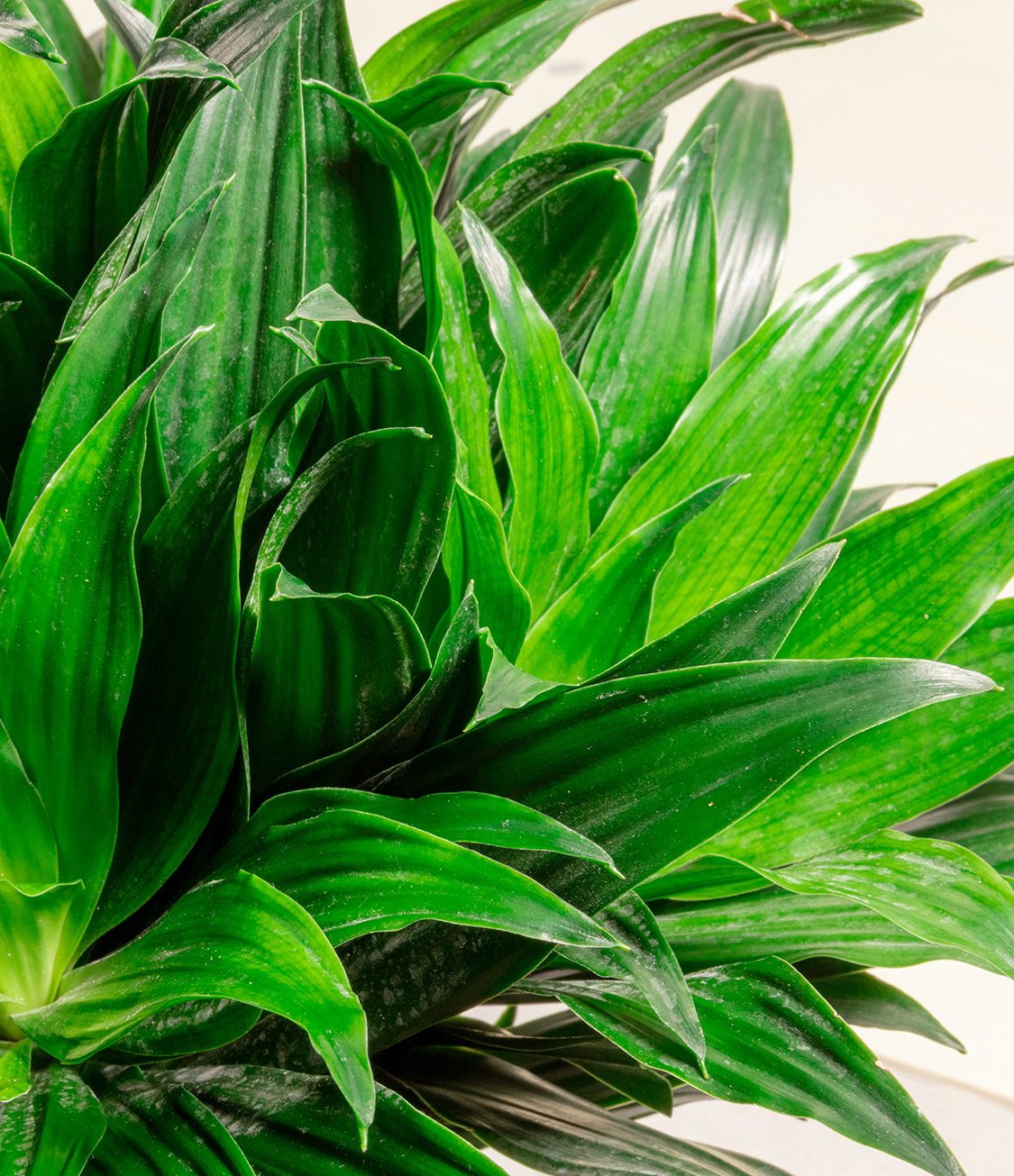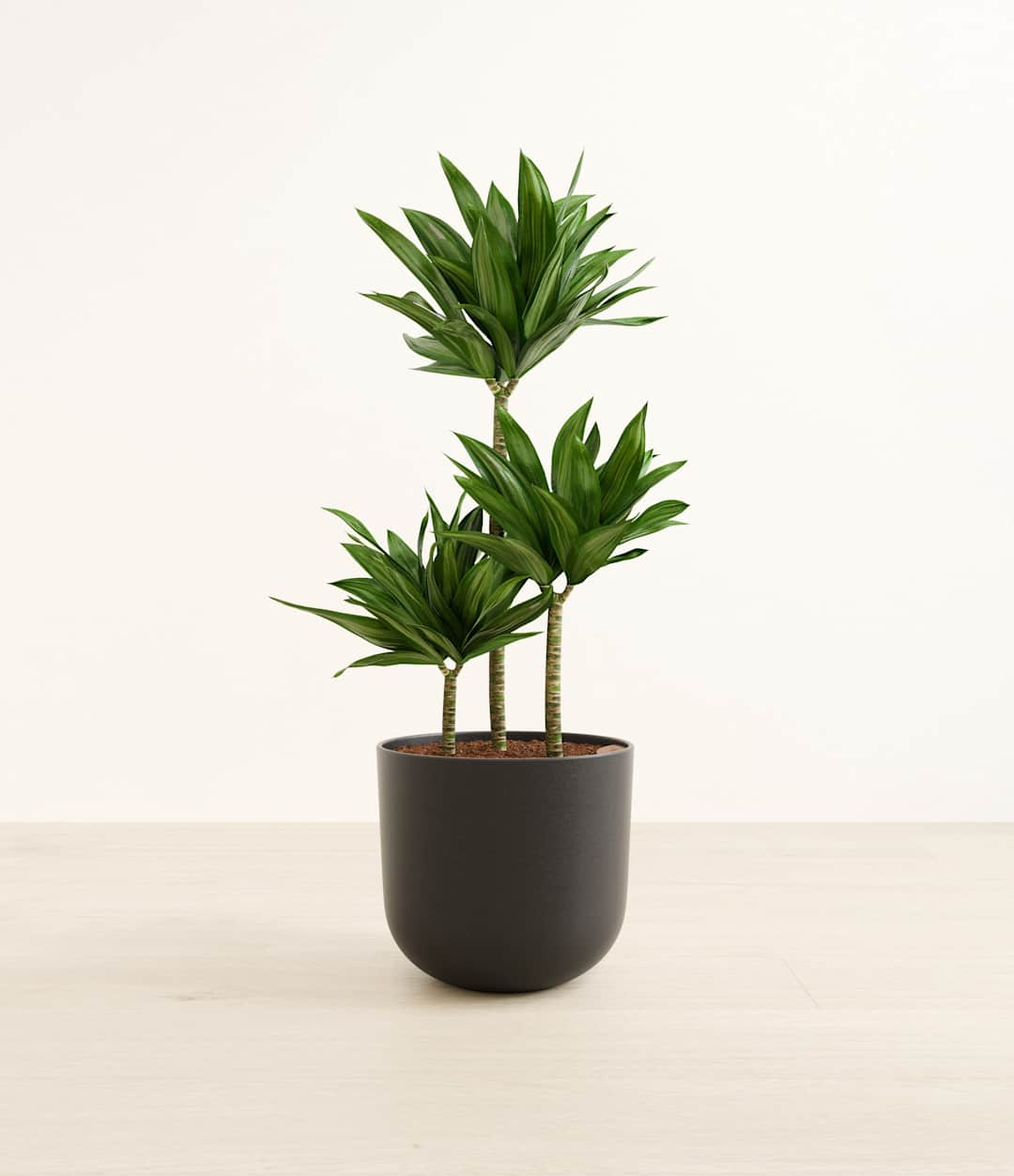Plant care library / Dracaena Janet Craig
How to Care for Dracaena Janet Craig
Shop this plantAbout Dracaena Janet Craig
Hailing from Africa, Dracaena Janet Craig, or Dracaena Deremensis, is named after the Derema Forest in Tanzania. As the original Deremensis disappeared from cultivation, it was replaced by its resilient, adaptable, and air-purifying daughter - Janet Craig, wearing a thick and wavy forest green foliage. As it evolves, Dracaena Janet Craig will drop a few lower leaves to be replaced by newer leaves on top.
Other common names
- Dracaena Deremensis
- Corn Plant
- Cornstalk Dracaena
How Often Should I Water My Dracaena Janet Craig
With easyplant, watering your Dracaena Janet Craig is simple. Make sure to check the easyplant reservoir once a month and fill it when empty, and you're all set!
If you don't have an easyplant, you should only water your Janet Craig Dracaena when 1/3 to 1/2 of the soil in its pot is dry; normally, this is every 10-14 days. This plant is not tolerant of overwatering, so it's important not to overwater. If the soil feels soggy or waterlogged, hold off on watering until the top 3-4 inches of the soil have dried out. It's also important to remember that Dracaena Janet Craig is sensitive to fluoride and other salts found in tap water; it's recommended that you use distilled or rain water instead.
Dracaena Janet Craig Light Needs
Dracaena Janet Craig grows best in a well lit space with bright direct or indirect sunlight, and can adapt to spaces with medium to low light, where the source of light is further away. Avoid placing it in spaces without natural sunlight.
Dracaena Janet Craig Plant Care
On your Dracaena Janet Craig’s first few days at home, it may lose several leaves, or leaves may turn yellow. This is no reason for concern. Simply shake off or cut the leaf, and look forward to new and better-adjusted leaves.
To help it grow optimally and evenly, occasionally dust the leaves and rotate the pot by a ¼ turn once a month. To maintain its aesthetic shape and height, you may periodically prune it to your liking.
How Big Do Dracaena Janet Craig Plants Grow?
Dracaena Janet Craig grows slowly, gradually developing into a small indoor tree reaching four to six feet tall after several years. As it grows tall, the trunk becomes bare, and the bottom leaves become yellow and fall off. This allows new leaves to grow up top, giving them a tree-like appearance.
Because of its slow growth, the Dracaena Janet Craig commonly takes at least ten years to reach its full height when grown indoors. When outdoors, the plant can grow up to 15 feet high. Factors that can impact the growth of this adaptable plant include location, low humidity, consistent low-light conditions, and an irregular watering schedule.
Temperature & Humidity
The Dracaena Janet Craig plant enjoys hot and humid weather since it is a tropical plant and will reach its fullest potential when kept at temperatures between 60-85F.
Although this plant can survive in regular home humidity, it would prosper more if the surrounding air was more humid--similar to its natural environment. These plants thrive as houseplants because of the higher humidity levels created in indoor environments.
Are Dracaena Janet Craig Toxic for Pets & Kids?
Dracaena Janet Craig may be moderately toxic if ingested, so be sure to keep away from curious children and pets. Though usually not deadly, this plant can cause some unpleasant symptoms if ingested by pets, so if your pet ingests this plant, seek immediate medical attention from your veterinarian. Similarly, this plant should not be consumed by humans due to its high saponin content. Ingestion of this plant may lead to gastrointestinal upset and other adverse reactions in some people.
Troubleshooting Common Problems with Dracaena Janet Craig
Keeping this plant near north or east-facing windows is an ideal strategy when trying to ensure it receives at least 4-8 hours of light per day but not too much direct sunlight. It's important to avoid direct sunlight, as this can cause the leaves of Dracaena Janet Craig to become dried out, yellow and scorched.
Frequently Asked Questions about Dracaena Janet Craig Plant
- How fast does a Janet Craig plant grow?Dracaena Janet Craig plants are slow growers but can grow up to 1-2 feet per year in ideal conditions, taking more than ten years to reach maturity. They thrive in bright indirect light and warm temperatures, so it is important to provide these conditions for optimal growth. Additionally, ensure water when the soil has dried out to help your plant reach its full potential.
- How tall do Janet Craigs grow?
Dracaena Janet Craigs typically grow to a height of 6-8 feet, although they can reach up to 15 feet in ideal conditions. They also have a spread of up to three feet.
- How do you care for Janet Craig Dracaena?To care for Dracaena Janet Craig, make sure it receives at least 4-8 hours of bright indirect light per day, water when 1/3 to 1/2 of the soil in its pot is dry (around every 10-14 days), keep the temperature between 60-85 F and maintain higher humidity levels if possible.
- How often should I water my Dracaena Janet Craig?You should water your Dracaena Janet Craig when 1/3 to 1/2 of its soil is dry, usually about every 10-14 days. It's important not to overwater this plant as it can be sensitive to fluoride and other salts found in tap water; use distilled or rain water instead for best results. To aid in consistent watering and minimize potential damage from overwatering, consider using easyplant's self-watering pot. Simply fill the reservoir once a month, and your Dracaena Janet Craig will receive the right amount of water it needs.

